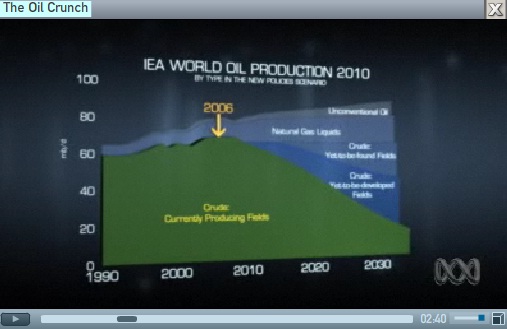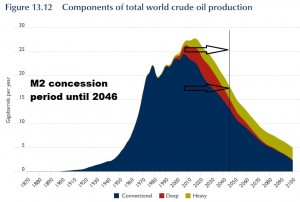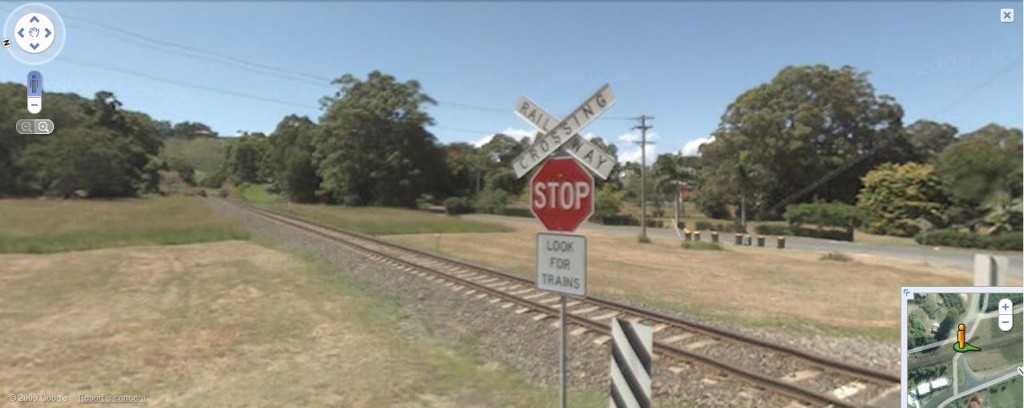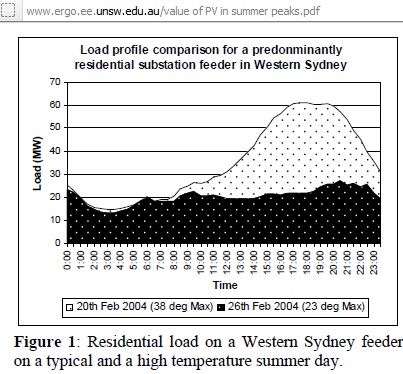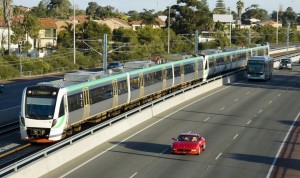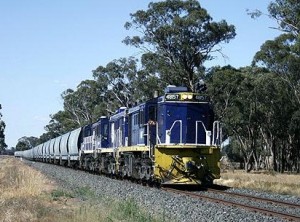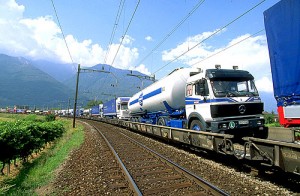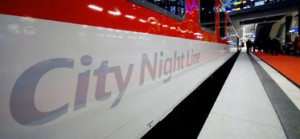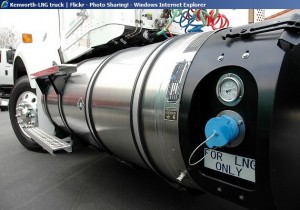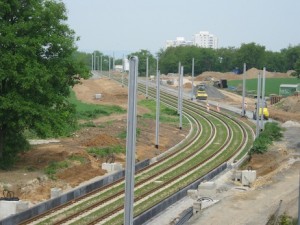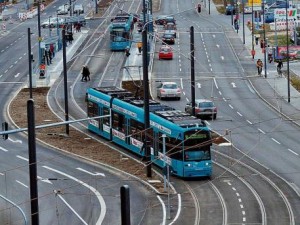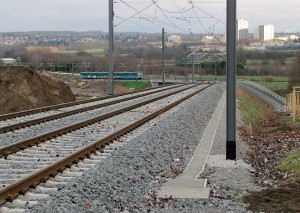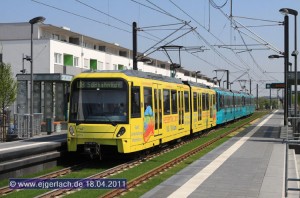In a discussion paper on a Transport Master Plan, released on 24/2/2012 and for which submissions closed in the last week of April, the NSW government thinks it can still debate the global conventional oil peak which happened in 2006. Although the paper asks interesting questions which invite comments, the motto seems to be: while we debate peak oil we can plan for eternal growth. Back to the drawing board, please.
 http://haveyoursay.nsw.gov.au/transportmasterplan
http://haveyoursay.nsw.gov.au/transportmasterplan
“The vision of the NSW Government is for a truly integrated transport authority which drives better transport outcomes for the NSW community.”
The Master Plan is full of statements which contradict both reality and other objectives in this document. There is no proper hierarchy of objectives
(1) Peak oil debate until judgement day
In section 2, page 34, we find this statement, containing a logical somersault:
“Like the rest of the world, NSW faces complex challenges relating to the supply and use of energy. ‘Peak oil’ is defined as the point in time when oil production reaches its maximum annual rate, after which the annual production rate declines each year. The point in time when supplies of conventional oil will peak is a hotly debated topic. However, while this debate occurs and solutions are explored, the demand for oil continues and the cost of oil increases. In Australia, demand for petroleum is projected to increase from more than 750,000 barrels per day to over 1.2 million barrels per day by 2029–30. This is an increase of almost two per cent per year over the period.”
Hotly debated? Not so. No one in the NSW government seems to have watched the ABC TV oil crunch show in April 2011 in which the chief economist of the IEA, Fatih Birol advised that the conventional oil peak happened in 2006. This is the screen shot:
Watch the interview: http://www.youtube.com/watch?v=iKkISqOCnVA
Dr Fatih Birol: The time is running out, the oil is today our lifeline, it is everywhere in the economy, if the prices go up or if there’s a supply disruption this will be definitely very bad news.
Dr Jonica Newby: How urgent is this?
Dr Fatih Birol: I think it would have been better if the governments have started to work on it at least ten years ago.
NARRATION: Houston – it’s just possible we have a problem.
http://www.abc.net.au/catalyst/stories/3201781.htm
10 years ago was 2001. And in the year 2012, the NSW government is still not getting away from oil. In the Transport Master Plan, past trends are assumed to continue:
“From these trends, it is clear there is likely to be continued growth of vehicle ownership, which in turn places pressure on road network performance. There need to be carefully planned investments in public transport to make it a more attractive choice and to alleviate the pressure on the road network. This is particularly the case where the public transport network has capacity to accommodate growth or where there is economic benefit in its further expansion. The high rate of growth in bicycle ownership and the trend to walking for the whole journey also need to be supported by investment in relevant infrastructure.” (p 29)
 Oh, and by the way, Australia consumes already 1 mb/d, not 750 kb/d. The NSW government can never get its oil- and energy- data right.
Oh, and by the way, Australia consumes already 1 mb/d, not 750 kb/d. The NSW government can never get its oil- and energy- data right.
The above trend is of course not compatible with the Federal government’s BITRE 117 report on peak oil.
(2) More highways and toll-ways
While the public transport part of the above statement (p. 29) is encouraging, the plan lists one highway project after the other and proposes more, typical for the whole paper:
Sydney
“The NSW Government is also expanding the M2 and M5 motorways to help improve access to the growth areas.” (p 39)
“An extension of the M4 would provide a motorway standard link between the Western Sydney Employment Area, Parramatta, Sydney CBD, Sydney Airport and Port Botany. Duplicating the M5 East would alleviate congestion near Sydney Airport and Port Botany and allow quicker journeys to warehousing and freight distribution locations in South West Sydney. An F3 to M2 link would provide motorway standard travel across Sydney connecting to the Central Coast and Newcastle.” (p 46)
Southern Region
“With the Hume Highway duplication now almost complete, the most important focus for the region is the ongoing upgrade of the Princes Highway. This involves progress towards four lanes as far as Jervis Bay, and safety improvements and overtaking lanes south to the Victorian border.” (p 70)
Hunter
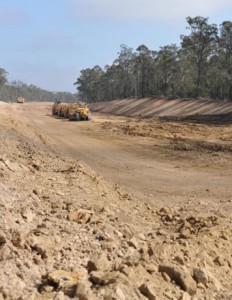 “The Hunter Expressway project will greatly improve road connections for the growing populations and economies of Maitland and Cessnock. The NSW Government has announced a $350 million Hunter Infrastructure and Investment Fund with a mandate to invest in infrastructure projects that will support the economic growth of the region.” (p 73)
“The Hunter Expressway project will greatly improve road connections for the growing populations and economies of Maitland and Cessnock. The NSW Government has announced a $350 million Hunter Infrastructure and Investment Fund with a mandate to invest in infrastructure projects that will support the economic growth of the region.” (p 73)
Quote from the plan: “The NSW Government is committed to working with the community to protect the environment.”
http://www.coffey.com/Uploads/Images/Work-commences-on-the-Hunter-Expressway_20111107150515.jpg
Mid North Coast
“In parallel to the forecast in population growth there is a growing freight task. Major projects such as the Kempsey Bypass and upgrades to the section south of Woolgoolga are underway on the Pacific Highway to improve road safety and support increased movements of freight. These upgrades will require good Pacific Highway access for high productivity vehicles. The NSW Government has prepared a submission to Infrastructure Australia to accelerate the Pacific Highway Upgrade Program to complete the full length of the highway between Hexham and the Queensland border by the end of 2016.” (p 73)
Newcastle – Sydney
“The links to Newcastle and Sydney will need improvement. This may necessitate F3 widening and a connection to the M2. The capacity of the Central Coast Highway and Old Pacific Highway may need to be increased.” (p 74)
Illawarra
The continuation of upgrades to the Princes Highway, particularly widening the highway to four lanes between Waterfall and Jervis Bay, will alleviate congestion between Sydney and Wollongong. (p 75)
(3) Rail
Rail, the only efficient transport solution to peak oil, is not on the radar.
Believe it or not: this is the main rail line between Sydney and Brisbane near Coffs Harbour. Shame on the NSW government.
And where big money is spent on urban rail it is for expensive tunnel solutions instead of extensive light rail networks. Competing toll-ways in the same corridors are also widened. So the job at hand, to replace car traffic with public transport, is not seen.
The NSW Government is already constructing the South West Rail Link [11.4 km] and is committed to building the North West Rail Link [23 km], which is in the detailed planning stage. Ensuring these train connections deliver accessible, well-connected and integrated transport are significant challenges for these areas. The NSW Government is also expanding the M2 and M5 motorways to help improve access to the growth areas. (p39)
South West Rail Link
This branch line to Leppington connects to a yet-to-be-built satellite city with 300 K residents on 17,000 ha, adjacent to Badgerys creek, possible site for another airport. This has been again proposed in a recent 2nd Sydney airport study. This area is the driest and hottest place (up to 45 degrees) in Sydney plus of course the noise from the airport, if it is ever built.
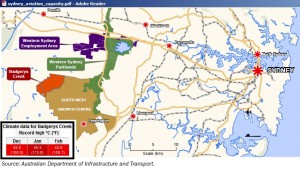 http://www.infrastructure.gov.au/aviation/sydney_av_cap/files/sydney_aviation_capacity.pdf
http://www.infrastructure.gov.au/aviation/sydney_av_cap/files/sydney_aviation_capacity.pdf
The air conditioning loads in summer will worsen an already very peaky electricity demand in Sydney’s West and will require additional expensive peaking power plants, leading to skyrocketing power bills for all residents in Sydney. No energy calculations have been done.
The priority for public transport is to replace existing car traffic, not create new traffic to suburbs which may not be sustainable and/or may not eventuate.
North West Rail Link
This project in the design phase is in competition to the M2 widening which will be completed maybe at the end of 2012. This rail link should have been built on the M2 itself, just like in Perth
This is solution is still possible on the 3rd lane. It may rescue Transurban from bankruptcy
12/2/2012
Car addicted Sindney destroys bus ramp near rail hub as tollway debt increases 60% at least
High Speed Rail
Any high speed rail option for NSW would require significant financial contributions. Therefore, careful consideration will have to be given to the role high speed rail could play in the future transport system of NSW and the economic, environmental and social merits of high speed rail development relative to alternatives. ( p 65)
I had written this article:
10/4/2011
Australia’s debating club on transport fantasies after global crude oil exports peaked 2005
Rural branch lines
There are around 3000 kilometres of non-operational rail lines across NSW where trains have ceased operating. This land represents a valuable resource for the community of NSW. In some cases, such as the Casino to Murwillumbah line, investigations are occurring into the viability of reintroducing services. In many other areas, it will be clear that rail will not be a viable use for the future and consideration should be given as to how best to use this corridor. (p 63)
This shows the whole mindset: sell off rail corridors which worked fine in an era without much oil.
Grain lines
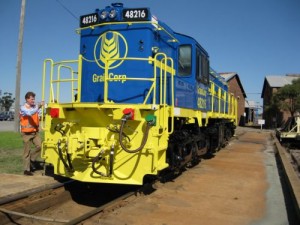 Work on the grain lines in recent years has included the re-railing and upgrading of the track from Gilgandra to Armatree on the Coonamble line to Class 3 standard. Class 3 track allows the operation of larger, heavier trains at higher speeds. The section from Armatree to Coonamble will be re-railed and upgraded to Class 3 standard by 2014. The line from Narrabri to Wee Waa has been upgraded and is operating at these higher levels. Work on the Wee Waa to Walgett section will be completed by June 2013 to bring this section to Class 3. These upgrades form part of the asset management plan for the Country Regional Network.
Work on the grain lines in recent years has included the re-railing and upgrading of the track from Gilgandra to Armatree on the Coonamble line to Class 3 standard. Class 3 track allows the operation of larger, heavier trains at higher speeds. The section from Armatree to Coonamble will be re-railed and upgraded to Class 3 standard by 2014. The line from Narrabri to Wee Waa has been upgraded and is operating at these higher levels. Work on the Wee Waa to Walgett section will be completed by June 2013 to bring this section to Class 3. These upgrades form part of the asset management plan for the Country Regional Network.
These stabilisation and upgrade works are being complemented by other initiatives. These include the procurement process for grain-specific rolling stock and contractually secured train operations to service the grain lines. This agreement involved the transfer of eighteen 48 Class locomotives and 180 wagons to GrainCorp. These are to be used for consolidation of grain from silos on the branch lines into the Werris Creek, Parkes, Temora and Junee sub-terminals, which is then transferred to main line trains that operate to the Port of Newcastle and Port Kembla terminals. Under these arrangements, GrainCorp is also obliged to service silos from other grain handlers. The agreement guarantees a minimum level of service for the grain lines. The provision of rail freight services beyond this level requires careful consideration taking into account overall freight priorities, the role of rail versus road and commercial matters. (p 79)
This is the only encouraging part of the plan. Transport of food will be one of the most important tasks.
Conclusion:
The proposed Transport Master Plan is not a preparation for the era of declining oil production. Back to the drawing board, please.
Solutions
Appendix:
Task ahead for Sydney
In order to appreciate the task to oil proof Sydney we need to look at the rail network of similarly sized European cities which built most of their rail lines before the advent of the car as the dominant mode of transport.
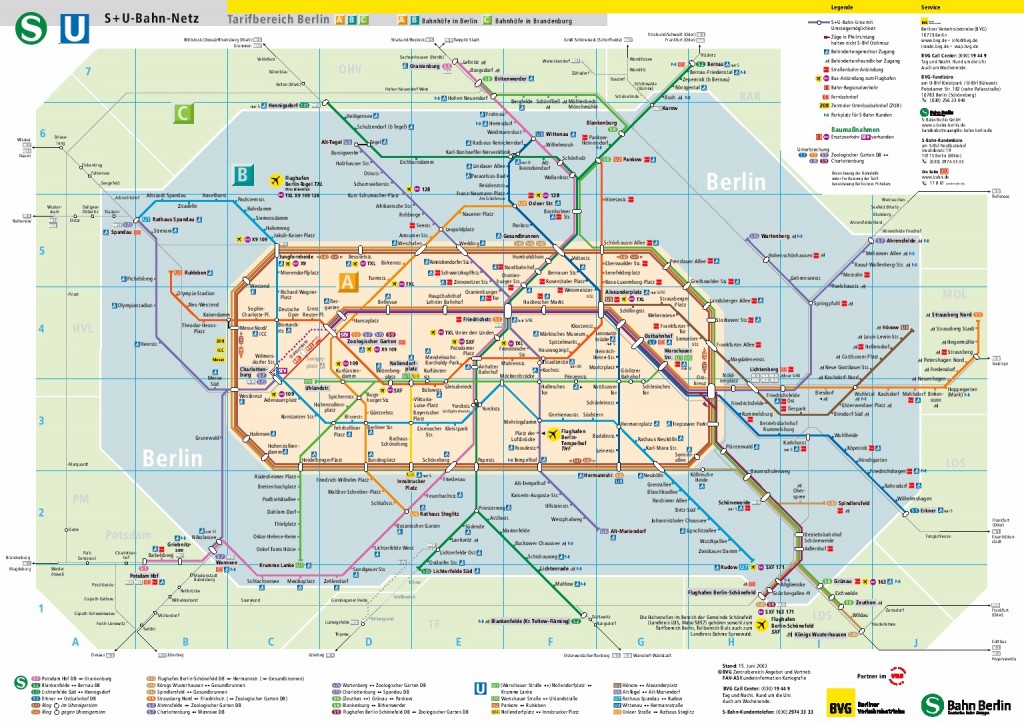 Rail map (heavy rail and metro) of Berlin, population 3.5 million, even smaller than Sydney. It is very clear that a similar density of rail service cannot be provided in Sydney before physical oil shortages appear at filling stations.
Rail map (heavy rail and metro) of Berlin, population 3.5 million, even smaller than Sydney. It is very clear that a similar density of rail service cannot be provided in Sydney before physical oil shortages appear at filling stations.
The most economic and the fastest way to build as many rail kms as possible is light rail. Here are some recent examples from Frankfurt:
Extension of tram 18 (light rail standard) at AU$ 20 million per km
Extension of hybrid metro/light rail U8 and U9 to new University campus
Sydney should spend $9bn earmarked for an expensive NWRL (just 23 kms) for such light rail solutions. Using the above cost (standard is equal to light rail) that would make 450 kms!!!
Every Council’s wish for a rail connection could be fulfilled. The problem now is of course the time available before the big bang in the Middle East. And the political insight and will.
Rolling stock is from Bombardier http://en.wikipedia.org/wiki/Flexity_Swift
The full version of my submission can be downloaded here:
Submission on NSW Transport Masterplan (PDF 3.2 Mb)
